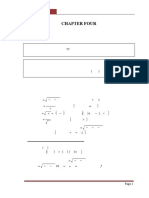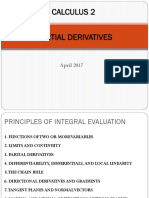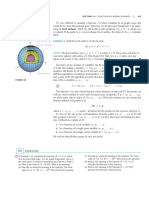0 ratings0% found this document useful (0 votes)
17 viewsNote
Uploaded by
agendoggetCopyright
© © All Rights Reserved
Available Formats
Download as PDF or read online on Scribd
0 ratings0% found this document useful (0 votes)
17 viewsNote
Uploaded by
agendoggetCopyright
© © All Rights Reserved
Available Formats
Download as PDF or read online on Scribd
You are on page 1/ 12
Functions of Two
or More Variables
Partial Derivatives
Limits and
Continuity
Differentiability
Directional
Derivatives and
Gradients
The Chain Rule
Tangent Planes
and
Approximations
Maxima and
Minima
‘The Method of
Lagrange
Multipliers
or
v v
emtin Range
Figure 1
Cost Func.
50
associates with the real number x another real number f(x). We cal
ued funetion of a teal variable. The second type of function, illustrated by
x°,e"), associates with the real number x a vector f(x), We call ita vector-
valued function of a real variable.
‘Our interest shifts now to a real-valued funetion of two real variables, that is,
function f (Figure 1) that assigns to each ordered pair (x,y) in some set D of the
plane a (unique) real number f(x, 3). Examples are
wo faye ear Sng) 4 =x’
2 wid) -2evy eras 4
Note that f(—1,4) = (—1)? + 3(4)? = 49 and g(-1, 4) = 2(-1) V4 = =,
“The set D is called the domain of the function. If tis not specified, we take
to be the natural domain, that is the set of all points (x,y) in the plane for
Which the function rale makes sense and ives a real number value. For
f(x.9) = x2 + 3y5 the natural domain is the whole planes for g(x,y) = 2vV¥.
itis {(x,y}:— © 0
(a) flw.xy.2)
0) Gsictiensty) = oped = b= a)
(0) Maistaeeta) = VIZ
+m)
40, Sketch (as best you can) the graph of the monkey saddle
2 al2" ~ 3p"). Begin by noting where z = 0.
41. The contour map in Figure 24 shows level curves for @
‘mountain 3000 feet high
(4). What is special about the path to the top labeled AC? What
is special about BC?
(b) Make good estimates of the total lengths of path AC and
path BC,
624 Chapter 12 Desivatives for Functions of Two oF More Variables
Figure 24
4 Identify the graph
(EAS Ror each ofthe functions in Problems 43-46, draw the graph
and the corresponding comour plot
4. fly) =sinVEES DS aS 2,
dsys2
A fly) = singa + yJO2+ 9°), 10,0)
Qexs)-2sys2
x(a
Qsxs2
46. f(xy) = (sin xsin y/(1 bP + YK-2 SS,
sys)
‘moO at
Answers to Concepts Review: 1, real-valued funetion of
to real variables. 2, level curvescontour map 3. concentric
ot f(ny)=a?— a+ 3y?+ — iteles_& paral lnes
2y ~ 13, state where iL attains its minimum value, and find this
12.2 Suppose that fis a function of two variables x and y. If v is held constant, say
ivati = jy then f(s ) isa function ofthe single variable x, Its derivative at x — xyis
Pantlal DEHWALVES TP pusil atadee off oth teed to rat agin) tow seed by
Falso3) TH, ockes a
feat den Meww | YO, BS
False.) = fim, PE 8
——__=___—____} anes
Similarly the partial derivative of f with respect to y at (x.y) is demoxd bys
Als 3) and is piven by 3
A 22
‘pteey) ~ tim £200 8) = F09)|go 4 00 2D
Praetiz |
den coy
Lz
lc.
ed ay
Rather than calculate f,(o.) and f,(2 3) directly from the boxed detini-
tions, we typically find f(y) and f(s.) using the standard rules for deriva-
tives; then we substitute x — ky and y — yg, The key point here is that the rules for
Cal
Sin(ay?y] + sings?) 2)
costey) 207) + sin(xy?)-2x
cos xy") +y? + 2xsin(xy*)
Goo. Go) = xy? cos(xy*) + 2xsin(xy*) CED
: Gea, E cos(xy?}-2xy = 2xy cos( ry")! Gey,
sen (Grrr) Us
Geometric and Physical Interpretations Consider the surface whose
equation is z = f(x, y). The plane y = 3p intersects this surface inthe plane curve
QPR (Figure 1), and the value of f,(xo, ) is the slope of the tangent line to this
eurve at P(x Sy f(o.3n))- Similarly, the plane x = xy intersects the surface in
the plane curve LPM (Figure 2), and f(x. yo) isthe slope of the tangent Tine 0
this curve at.
Partial derivatives may also be interpreted as (instantaneous) rates of change.
Suppose that a violin string is fixed at points A and B and vibrates in the xz-plane.
Figure 3 shows the position of the string ata typical time «If = = f(x) denotes
the height of the string atthe point P with x-coordinate x at time f,then d2/8x is the
slope ofthe string at P. and dz/at isthe time rate of change of height of P along the
indicated vertical Hine. In other words, 2/0 isthe vertial velocity of P.
EXAMPLE 3] The surface z= f(x,y) = V9— 2x? — y? and the plane
y= | intersect in a curve as in Figure 1. Find parametric equations for the tangent
tine at (V2, 1,2).
SOLUTION
Fy—ty)
yo-22
FAXY)
and s0 f( V2.1) = V2. This number isthe slope of the tangent line to the
stint curve at (V3. 1,2): thatis,~V3/1 i the ratio of rs o um along the tangent in.
om yicn) Tt follows that this line has direction veetor (1, 0,2) and, since it goes through
(v2.1.2),
x=V24q0 yu 2=2= Vee
Figure 3 provide the required parametric equations .
626 Chapter 12 Derivatives for Functions of Two or More Variables
Tungnen Jai
Gedy One
ors = et —
SOLUTION
2 Ariss)
: a
= 43% ee Hef) goes
2 aye fy) = ae + Sen(2) +20y
BEEXASPEES) the volume ofa certain gap is elated tits temperature Zand
its pressure P by the gas law 2 107", where V is measured in cubic inches, P in
pounds per aquare inch, and Tin degrees Kelvin. If Vis kept constant at S0,what is
nfeadte rate of change of prestre with respect to temperature when 7 200?
Ketegatan TWA = Gatien ae
SOLUTION See P= P= 1oriV,
7
ne
ov
P Oo 20 °
“Thus the pressute is increasing at the rate of £ pound per square inch per degree
Kelvin, .
Higher Partial Derivatives Since a partial derivative of a function of x and
{vis in general, another function of these same two variables it may be differenti
‘ated partially with respect to either x oF y, resulting in four second partial deriva-
ives tf
a ? pe
tw 5)
= day=Z| B-a, fan Gn BE) - SE
[EXAMPLES] Find the four second partial derivatives of
fs.) = x0? — sin(x/y) + ey > =
fi
afte) > ssi ) +62
ae ian?
fol y) =
sols) + pa) vee
GryeGrey
Notice thatin Example 5, fy = fy: Which is usually the ease for the functions
‘of two variables encountered in a first course. A criterion for this equality will be
given in Section 123 (Theorem C)..
Partial derivatives of the third and higher orders are defined analogously, and
‘the notation for them is similar. Thus, if isa function of the two Variables x and y,
the third partial derivative of f obtained by differentiating f partially, first with re-
spect to x and then twice with respect 10 y, will be indicated by
alG)|-lGm) ~ ae
Altogether, there are eight third partial derivatives.
Feb. 9) =
sie)-Saee 8
Section 12.2 Partial Derivatives 627
Se
Ga More Than Two Variables Let fhe a funetion of three variables, x,y. and
y partial derivative of f with respect to x at (x,y, 2) is denoted by fy(4, ¥, 2) ar
f(x, », 2)/ax and is defined by
ov
x fie yee) = jim F* Bez) = flnez) 4
x Xe Ae ea) = ey ar
“LY ‘Thus. f(x. », 2) may be obtained by treating y and 2 as constants and differentiat-
Bx ing with respect to.
‘The partial derivatives with respeet to yand z are defined in an analogous way.
delka Partial derivatives of functions of four or more Variables are defined similarly (see
Problem 49). Partial derivatives, such as fiy and f,,., that involve differentiation
with respect to more than one variable are ¢alled mixed partial deri
Tray,
SOLUTION To get f,, we think of y and z as constants and differentiate with
respect to the variable ¥. Thus,
ay + 2yz + Bex, find ff, and f.
Fale yse) = y + 32
To find f, we treat x and z as constants and differentiate with respect toy:
Aloay2) =x +e
Similarly,
Filey.) = 2y +38 .
It T(x. yt) = 22 fi
wag LO ET ag PT
wax ax au! a
i all first partial derivatives
SOLUTION The four first partials are
TB ayeteee
com
ar
a
T 8 (agetseeys eneay
ST Byer) = Dye
8 titty aly
Fee)
‘The other partial derivatives are
PTF _yaterivy 2 rygees seas
wax” dwax D> yg ate fe
ier weeey
= dunce’
ar
Concepts Review
1. Asa limit, f,(%. yo) 8 defined by __and is called the 3. Another notation for f,,(x, y) is__.
G0 A. 1/89) = C2) + MN thEH Fly
2 f(xy) FOG ¥) = Bl hs lt ¥)
A(1,2) = —_.
Py, then f0,2) = and
628 Chapter 12 Des
Problem Set 12.2
In Problems 1-16, find all frst paral derivatives of each function.
2 flay) = x= 4
Flay) = Gx ~ yy"
aren= a seen
SK fan=Oine 6 Slayers yy
7 fixy) = & f(u.v) =e"
% Bixy) =e" 10. f(s,¢) = Inf? — 2)
1 fxs)
You might also like
- Section 14.1 Functions of Several VariablesNo ratings yetSection 14.1 Functions of Several Variables6 pages
- CH-1 Differential Calculus of Functions of Several VariablesNo ratings yetCH-1 Differential Calculus of Functions of Several Variables21 pages
- Unit 4 and Unit 5 Functions of Several VariablesNo ratings yetUnit 4 and Unit 5 Functions of Several Variables318 pages
- Lesson 2.1 Functions of Several Variables - EditedNo ratings yetLesson 2.1 Functions of Several Variables - Edited10 pages
- Lesson 24 Domain and Range of Multi Variable FunctionsNo ratings yetLesson 24 Domain and Range of Multi Variable Functions21 pages
- Unit 5 PT 1 Functions Several VariablesNo ratings yetUnit 5 PT 1 Functions Several Variables15 pages
- LECTURE - 2 (2-3 Weeks) - FSV-Domain of Function and Parametrization of Line-Curve - S2 - 2022-2023No ratings yetLECTURE - 2 (2-3 Weeks) - FSV-Domain of Function and Parametrization of Line-Curve - S2 - 2022-202322 pages
- Calculus Ii: Unit 1: Functions of Several VariablesNo ratings yetCalculus Ii: Unit 1: Functions of Several Variables63 pages
- Chapter 13 PARTIAL DERIVATIVES Pertemuan 1 Dan 2 6 April 2020 PDFNo ratings yetChapter 13 PARTIAL DERIVATIVES Pertemuan 1 Dan 2 6 April 2020 PDF107 pages
- Chapter 3 Differential Calculus of Function of Several Variables (1)No ratings yetChapter 3 Differential Calculus of Function of Several Variables (1)30 pages
- Openstax - Multivariable Functions & Partial DerivativesNo ratings yetOpenstax - Multivariable Functions & Partial Derivatives144 pages
- Chapter 5: Functio Ns of Several Vari AblesNo ratings yetChapter 5: Functio Ns of Several Vari Ables94 pages
- CH-1 Differential Calculus of Functions of Several VariablesCH-1 Differential Calculus of Functions of Several Variables
- Lesson 2.1 Functions of Several Variables - EditedLesson 2.1 Functions of Several Variables - Edited
- Lesson 24 Domain and Range of Multi Variable FunctionsLesson 24 Domain and Range of Multi Variable Functions
- LECTURE - 2 (2-3 Weeks) - FSV-Domain of Function and Parametrization of Line-Curve - S2 - 2022-2023LECTURE - 2 (2-3 Weeks) - FSV-Domain of Function and Parametrization of Line-Curve - S2 - 2022-2023
- Calculus Ii: Unit 1: Functions of Several VariablesCalculus Ii: Unit 1: Functions of Several Variables
- Chapter 13 PARTIAL DERIVATIVES Pertemuan 1 Dan 2 6 April 2020 PDFChapter 13 PARTIAL DERIVATIVES Pertemuan 1 Dan 2 6 April 2020 PDF
- Chapter 3 Differential Calculus of Function of Several Variables (1)Chapter 3 Differential Calculus of Function of Several Variables (1)
- Openstax - Multivariable Functions & Partial DerivativesOpenstax - Multivariable Functions & Partial Derivatives























































